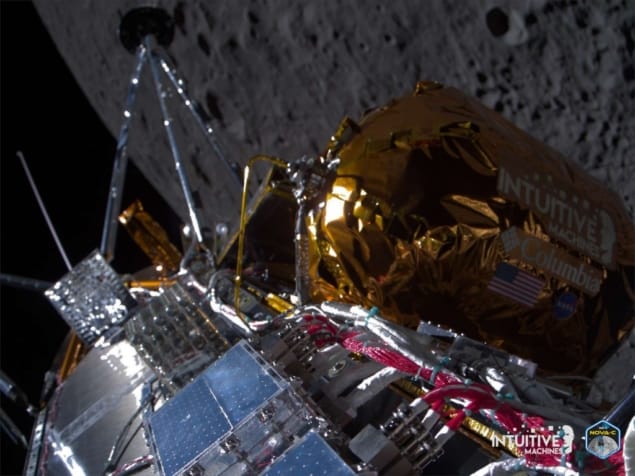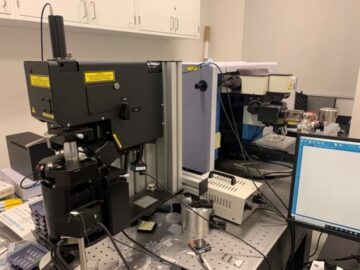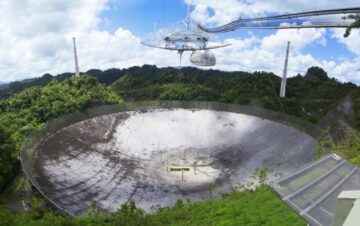
A private US firm has successfully made a soft landing on the Moon. The Odysseus mission touched down at 6:24 p.m. ET on Thursday on the Moon’s Malapert A region, a small crater about 300 km from the lunar south pole. Roughly the size of a red telephone box, the craft becomes the first US mission to make a soft landing on the Moon since Apollo 17 took astronauts Eugene Cernan and Harrison Schmitt to the lunar surface in December 1972.
The mission, aka IM-1, after the Houston-based company Intuitive Machines that operates it, carries an optical telescope, dubbed ILO-X, and a radio telescope called ROLSES. The two telescopes delivered by Odysseus now join one that arrived on China’s Chang’e-3 mission in 2013.
ILO-X will take advantage of the Moon’s lack of an atmosphere to image the Milky Way, the Large Magellanic Cloud and the Carina nebula, among other objects. ROLSES – short for Radiowave Observations at the Lunar Surface of the photoElectron Sheath – will use four antennas to study interactions between the Earth’s and Sun’s magnetic fields.
The mission also carries four NASA instruments while non-NASA payloads include 125 miniature Moon sculptures inside a transparent cube that have been created by artist Jeff Koons.
The flight and the touchdown, however, wasn’t all plain sailing. A post-launch test of the craft’s main engine was postponed after it took longer than expected to chill the liquid oxygen feed line. Close to the scheduled time for leaving lunar orbit, engineers gave the craft one extra spin around the Moon.
Then a problem with the craft’s navigation system forced engineers to switch to using NASA’s Navigation Doppler Lidar – an experimental payload on board the craft – to guide it down.
Mission control also had difficulty communicating with the craft for a few tense minutes after it landed. “I know this was a nail-biter, but we are on the surface, and we are transmitting,” Steve Altemus, chief executive officer of Intuitive Machines noted.
‘Power and promise’
Odysseus’s success is more than being the first US lunar lander in more than half a century. It also becomes the first commercial craft to land on the Moon. NASA contracted it to carry its payloads as part of the agency’s Commercial Lunar Payload Services programme. By contracting out missions to the private sector rather than carrying them out on its own, NASA hopes to reduce their costs significantly.
“Today is a day that shows the power and promise of NASA’s commercial partnerships,” NASA Administrator Bill Nelson noted.

Japan’s lunar lander falls head over heels for the Moon
Efforts to land craft on the Moon have had a mixed record during the past year. Hakuto-R, a craft developed by Japanese company Ispace, crash-landed last April and Russia’s Luna 25 met the same fate four months later.
Yet India’s Chandrayaan-3 craft did touch down successfully last August. Last month a propulsion system problem early in flight caused Astrobiotic Technology to give up hope of even setting down its Peregrine robotic landing craft on the lunar surface, while Japan’s Smart Lander for Investigating Moon (SLIM) landed at an angle that initially limited its ability to power up and collect data.
- SEO Powered Content & PR Distribution. Get Amplified Today.
- PlatoData.Network Vertical Generative Ai. Empower Yourself. Access Here.
- PlatoAiStream. Web3 Intelligence. Knowledge Amplified. Access Here.
- PlatoESG. Carbon, CleanTech, Energy, Environment, Solar, Waste Management. Access Here.
- PlatoHealth. Biotech and Clinical Trials Intelligence. Access Here.
- Source: https://physicsworld.com/a/us-odysseus-mission-becomes-first-private-craft-to-successfully-land-on-the-moon/
- :has
- :is
- ][p
- $UP
- 120
- 125
- 17
- 2013
- 24
- 25
- 300
- 6
- 90
- a
- ability
- About
- ADvantage
- After
- aka
- All
- also
- among
- an
- and
- angle
- apollo
- ARE
- around
- arrived
- artist
- AS
- ascend
- At
- Atmosphere
- AUGUST
- become
- becomes
- been
- being
- between
- Bill
- board
- bound
- Box
- but
- by
- called
- carry
- carrying
- caused
- Century
- chief
- Chief Executive
- chief executive officer
- Chinas
- Close
- Cloud
- collect
- commercial
- communicating
- company
- contracting
- control
- Costs
- courtesy
- craft
- created
- data
- day
- December
- delivered
- developed
- DID
- Difficulty
- down
- dubbed
- during
- E&T
- Early
- Engine
- Engineers
- eugene
- Even
- executive
- Executive Officer
- expected
- experimental
- extra
- Falls
- few
- Fields
- Firm
- First
- flight
- For
- forced
- four
- from
- gave
- guide
- had
- Half
- Have
- head
- hope
- hopes
- However
- HTTPS
- image
- in
- include
- information
- initially
- inside
- instruments
- interactions
- intuitive
- investigating
- issue
- IT
- ITS
- Japan’s
- Japanese
- join
- jpg
- Know
- Lack
- Land
- landing
- large
- Last
- later
- leaving
- lidar
- Limited
- Line
- Liquid
- longer
- Luna
- Lunar
- lunar lander
- Machines
- made
- Main
- make
- max-width
- Milky way
- minutes
- Mission
- missions
- mixed
- Month
- months
- Moon
- more
- Nasa
- Navigation
- Nebula
- noted
- now
- objects
- observations
- of
- Officer
- on
- ONE
- operates
- optical
- Orbit
- Other
- out
- over
- own
- Oxygen
- part
- partnerships
- past
- Physics
- Physics World
- Plain
- plato
- Plato Data Intelligence
- PlatoData
- post-launch
- power
- private
- private sector
- Problem
- programme
- promise
- propulsion
- Radio
- rather
- record
- Red
- reduce
- region
- Robotic
- roughly
- sailing
- same
- scheduled
- sector
- setting
- Short
- Shows
- significantly
- since
- Size
- small
- smart
- Soft
- South
- Spin
- Study
- success
- Successfully
- Surface
- Switch
- system
- Take
- Technology
- telescope
- telescopes
- test
- than
- that
- The
- their
- Them
- this
- thumbnail
- thursday
- time
- to
- took
- touched
- transparent
- true
- two
- us
- use
- using
- was
- Way..
- we
- while
- will
- with
- world
- year
- zephyrnet












